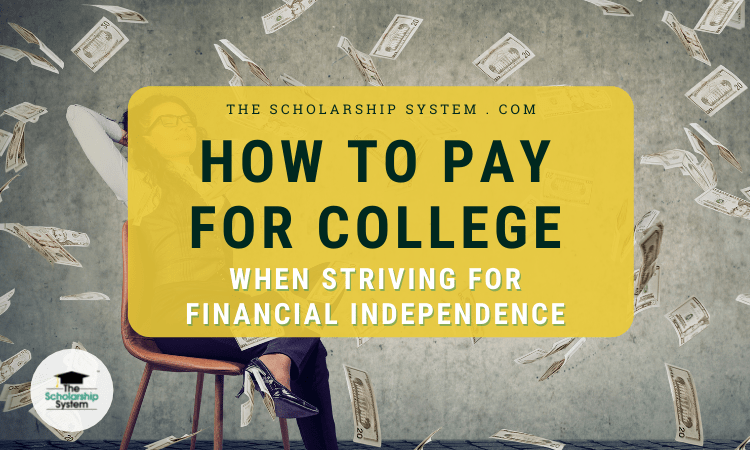Updated on July 12th, 2022
A financial movement is catching FIRE across the nation. Financial independence and retire early, or FIRE, focuses on achieving money- and retirement-related goals early in life, allowing people to exit the working world at a younger age or have the option for pursuing less lucrative employment options because they make them happy. It gives followers of the movement the ability to release themselves from long hours or jobs they dislike since their financial well-being isn’t tied to traditional employment.
If your student is trying to avoid debt, scholarships are a great option. They can cover a range of college costs and don’t have to be paid back. If you and your student want to learn about scholarships, sign up for our free college scholarship webinar! Take a quick trip over to http://thescholarshipsystem.com/freewebinar to reserve a spot today.
For many parents and students alike, the ideas behind FIRE are incredibly enticing. But, when you consider what families must resort to when it comes to paying for school (we’re looking at you student loans!) it seems like the two ideas don’t mix. But that doesn’t have to be the case.
Here is what we are going to cover:
How to reach financial independence while paying for college:
- Start now and start big by setting goals
- Keep monthly expenses low
- Avoid student loans and college debt by securing scholarships and finding more affordable options
- Pay in cash
- Don’t forget to have some (fiscally responsible) fun
Principles Behind Financial Independence
At its core, FIRE is incredibly simple. The goal is to eliminate debt, fund retirement accounts, bolster savings, and even invest as methods to secure one’s financial future.
Financial independence is achieved when enough personal wealth has been acquired that you don’t have to work to pay for the necessities of life. That doesn’t mean you don’t work – just that you don’t have to work to survive.
Generally, the necessities include certain unavoidable costs, like food, insurance, utilities and certain housing expenses. Additional costs, like entertainment, can also be factored in if the person so chooses.
The point of financial independence is normally considered reached when the person’s assets generate enough income to support their lifestyle without them having to sacrifice any of the actual assets. And, by working to keep monthly expenses low, this is easier to achieve.
If you want to learn more about the FIRE movement, I really liked this article with a breakdown, including how to calculate the amount of money needed to be “financially independent” (*This varies of course!)
A really good breakdown of what FIRE is: The Secret FIRE Cult – And Why You’ll Want to Join It.
Lastly, to understand how you can increase your chances of having enough money, here are some details on “fatFIRE” which calculated your figure so your funds have a 97% chance of lasting you at least 30 years without working.
Financial Independence and Paying for College
Now let’s get to why we are talking about this on a scholarship website:
For many, the FIRE movement begins after college upon securing a full-time job. This is when there is a consistent income and a 401k. Many have already accumulated student loans, and possibly a mortgage or a car payment at this point; therefore, they work to quickly pay off their debt and save at the same time. They make specific sacrifices to make up for past decisions, so they can be in better control of their future.
The reason I wanted to write about this topic is because I want to urge families to accelerate this discussion. There is no need to wait until post-college to begin working towards financial independence. This conversation should begin sooner.
How much sooner?
In reality, working towards financial independence can begin much younger, but at the very least, it should begin when deciding on colleges (not after).
Why?
Because understanding the FIRE movement, and setting a goal to have financial freedom both for your family and for your child, can be a target that helps them make better decisions when it comes to the cost of college.
Managing the associated expense of college and student debt makes the concept of planning for the future challenging, especially when your child is stuck paying off the past. If instead, students can find ways to limit the amount of debt they have to borrow, they can start off with a leg up. And if financial freedom is a goal of yours and your child’s, how you choose to pay for college can be a determining factor of whether or not you meet that goal.
Financial independence and paying for college can go hand-in-hand if your student uses the right approach.
With that in mind, here are five steps that can help you and your child work toward financial independence before, during, or after they finish paying for college.
1. Start Now and Start Big by Setting Goals
The earlier your student makes financial independence a goal, the better.
Often, decisions made earlier in one’s life have a significant impact on financial well-being in the future. For example, compound interest can be a powerful tool when the savings has time to sit untouched, but waiting for even a few years to get started can mean a significant decrease in the ultimate value of the account.
Retirement savings works similarly, so getting an account started as quickly as possible can be critical for reaching financial independence. And, by paying down debt fast, your student lowers the amount of interest they have to pay, saving the money while they work to bring their balance to zero.
Additionally, the more money that can be directed towards paying off debt, savings, and investing, the better. While it may require a big sacrifice upfront, being able to free themselves from money strains over the long-term makes it worth the effort. Help your child set goals for financial freedom, including goals to save and reduce debt as quick as possible. 2
2. Keep Monthly Expenses Low
Your child will need to control their monthly expenses to help free up precious cash (or avoid unnecessary debt) and make financial independence easier to achieve. This involves everything from finding affordable housing to getting the lowest cost smartphone plan that meets their needs.
Often, this means your student (if they are going away to college) needs to select the lowest cost housing option available that they find tolerable, keep their food budget in check, and avoid debt.
Again, the goal is to get their regular expenses as low as possible, making life more affordable overall.
Here are some of our favorite articles on how to save money in college:
3. Avoid Student Loans and College Debt
One of the easiest ways to reconcile financial independence goals with paying for college is to avoid student debt entirely. 3
There are plenty of ways to pay for college that don’t involve debt. For example, your student may qualify for grants through their FAFSA that can cover some of their costs or can apply for scholarships to reduce or eliminate the financial burden.
Scholarship options are widely available, as long as your child knows where to look and is willing to put in an effort to support their financial independence goals.
If you and your child would like to learn more about applying for scholarships, sign up for our free college scholarship webinar! It’s a great way to learn about the process and see how scholarships can help your student graduate from college debt-free!
Your student also has the option of negotiating their tuition which can help make their top choice school more affordable. You can learn more about that process here: 5 Steps to Negotiate College Tuition and Save Thousands of Dollars.
Some schools even offer free tuition, like the ones listed here: Free College Tuition is Actually Possible at These Schools. Don’t be afraid to consider less-traditional paths if it means a debt-free degree. This can include bridge programs as well!
Your child can also get a job while they are still in school. There are some great options for students such as the ones covered in 7 High Paying Jobs for College Students & High Schoolers or 4 Part-Time Jobs That Offer Tuition Reimbursement. Plus, if they have a job, your student may gain access to retirement benefits that can help them start working toward financial independence. 4
4. Pay in Cash
Many people turn to financing options for large purchases, but this can quickly lead to trouble and make attaining FIRE goals more challenging. Instead of using debt to buy something, your child should focus on saving up for large purchases and paying in cash.
While they may feel like not having a television is an emergency, it isn’t. In fact, many large purchases have nothing to do with immediate needs, just immediate wants. So, instead of turning to credit cards, if your student learns to save first, reaching financial independence will be easier. 5
5. Don’t Forget to Have Some (Fiscally Responsible) Fun
College can be stressful, so cutting loose from time to time is practically a necessity, but blowing hundreds of dollars on a night out isn’t.
Your child shouldn’t be afraid to occasionally spend a little money on themselves. Instead, they should seek out fiscally responsible options that let them have a good time without breaking the bank. After all, they are working hard, and taking some time to enjoy themselves is healthy.
We included some low-cost entertainment options in the article 75 Easy Ways to Save Money in College. Plus, there are a lot of other savings tips in their too, including methods for reducing living expenses and making college costs more reasonable.
By focusing on the tips above, your child can make it possible to work toward financial independence even while paying for college, creating a win-win situation and, hopefully, giving them greater control over the rest of their lives.
If your student is trying to avoid debt, scholarships are a great option. They can cover a range of college costs and don’t have to be paid back. If you and your student want to learn about scholarships, sign up for our free college scholarship webinar! Take a quick trip over to http://thescholarshipsystem.com/freewebinar to reserve a spot today.








Leave a Reply